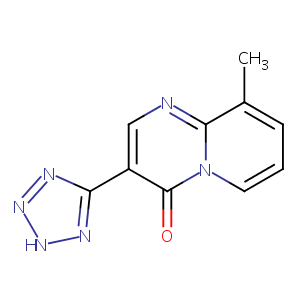Drug Information
| Drug General Information | Top | |||
|---|---|---|---|---|
| Drug ID |
D0K5LQ
|
|||
| Former ID |
DAP001064
|
|||
| Drug Name |
Pemirolast
|
|||
| Synonyms |
Pemirolastum; Pemirox; Pemirolast [INN]; Pemiroplast Potassium; Alamast (TN); Alegysal (TN); Pemirolast (INN); Pemirolastum [INN-Latin]; Pemirox (TN); 9-TBX; 9-methyl-3-(1H-tetrazol-5-yl)-4H-pyrido(1,2-a)pyrimidin-4-one; 9-methyl-3-(2H-tetrazol-5-yl)pyrido[1,2-a]pyrimidin-4-one
Click to Show/Hide
|
|||
| Drug Type |
Small molecular drug
|
|||
| Indication | Allergic conjunctivitis [ICD-11: 9A60.02; ICD-10: H10.1] | Approved | [1], [2], [3] | |
| Therapeutic Class |
Antiallergic Agents
|
|||
| Structure |
 |
Download2D MOL |
||
| Formula |
C10H8N6O
|
|||
| Canonical SMILES |
CC1=CC=CN2C1=NC=C(C2=O)C3=NNN=N3
|
|||
| InChI |
1S/C10H8N6O/c1-6-3-2-4-16-9(6)11-5-7(10(16)17)8-12-14-15-13-8/h2-5H,1H3,(H,12,13,14,15)
|
|||
| InChIKey |
HIANJWSAHKJQTH-UHFFFAOYSA-N
|
|||
| CAS Number |
CAS 69372-19-6
|
|||
| PubChem Compound ID | ||||
| PubChem Substance ID |
8185373, 14773738, 14822841, 43115342, 46509034, 50065081, 50563413, 57313910, 85209679, 93166875, 96024435, 104313292, 123092154, 128063839, 131269071, 134338322, 135035415, 137007584, 137035161, 142971147, 160964226, 162178777, 164814579, 175268367, 178103901, 179150951, 179326618, 223797099, 226416213, 252355732
|
|||
| ChEBI ID |
CHEBI:134936
|
|||
| ADReCS Drug ID | BADD_D01703 ; BADD_D01704 | |||
| Interaction between the Drug and Microbe | Top | |||
|---|---|---|---|---|
| The Abundace of Studied Microbe(s) Regulated by Drug | ||||
| The Order in the Taxonomic Hierarchy of the following Microbe(s): Bacteroidales | ||||
|
Studied Microbe: Parabacteroides distasonis
Show/Hide Hierarchy
|
[4] | |||
| Hierarchy | ||||
| Abundance Change | Decrease | |||
| Experiment Method | High-throughput screening | |||
| Description | The abundance of Parabacteroides distasonis was decreased by Pemirolast potassium (adjusted p-values: 6.80E-03). | |||
|
Studied Microbe: Parabacteroides merdae
Show/Hide Hierarchy
|
[4] | |||
| Hierarchy | ||||
| Abundance Change | Decrease | |||
| Experiment Method | High-throughput screening | |||
| Description | The abundance of Parabacteroides merdae was decreased by Pemirolast potassium (adjusted p-values: 3.85E-03). | |||
| Target and Pathway | Top | |||
|---|---|---|---|---|
| Target(s) | Histamine H1 receptor (H1R) | Target Info | Antagonist | [5] |
| KEGG Pathway | Calcium signaling pathway | |||
| Neuroactive ligand-receptor interaction | ||||
| Inflammatory mediator regulation of TRP channels | ||||
| Panther Pathway | Histamine H1 receptor mediated signaling pathway | |||
| Reactome | Histamine receptors | |||
| G alpha (q) signalling events | ||||
| WikiPathways | Monoamine GPCRs | |||
| GPCRs, Class A Rhodopsin-like | ||||
| IL-4 Signaling Pathway | ||||
| Gastrin-CREB signalling pathway via PKC and MAPK | ||||
| GPCR ligand binding | ||||
| GPCR downstream signaling | ||||
| References | Top | |||
|---|---|---|---|---|
| REF 1 | URL: http://www.guidetopharmacology.org Nucleic Acids Res. 2015 Oct 12. pii: gkv1037. The IUPHAR/BPS Guide to PHARMACOLOGY in 2016: towards curated quantitative interactions between 1300 protein targets and 6000 ligands. (Ligand id: 7329). | |||
| REF 2 | Drugs@FDA. U.S. Food and Drug Administration. U.S. Department of Health & Human Services. 2015 | |||
| REF 3 | Emerging drugs for ocular allergy. Expert Opin Emerg Drugs. 2005 Aug;10(3):505-20. | |||
| REF 4 | Extensive impact of non-antibiotic drugs on human gut bacteria. Nature. 2018 Mar 29;555(7698):623-628. | |||
| REF 5 | The effect of a combined therapy with a histamine H1 antagonist and a chemical mediator release inhibitor on allergic conjunctivitis. Ophthalmologica. 2008;222(4):232-9. | |||
If You Find Any Error in Data or Bug in Web Service, Please Kindly Report It to Dr. Zhou and Dr. Zhang.

